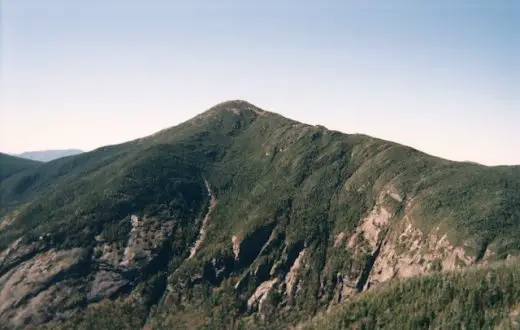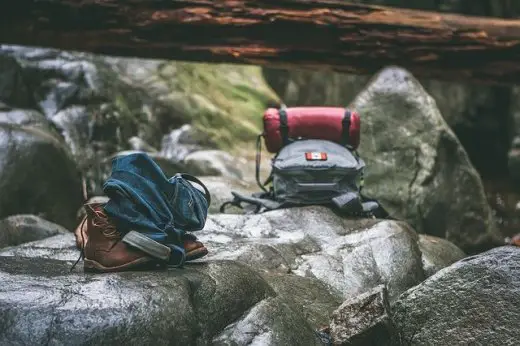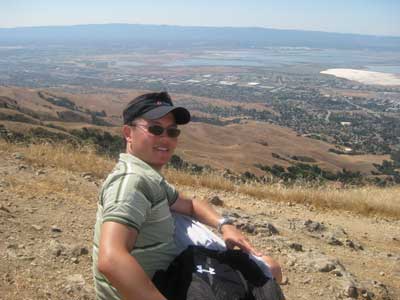
If you want a hiking challenge, climbing to the summit of Mount Marcy will give you just that. Marcy is the highest mountain in the Adirondacks, and subsequently all of New York, with an elevation of 5,344 feet.
While it’s challenging, you don’t have to be particularly skilled to make it to the top. That being said, it does have its fair share of varied terrain, so you can expect a long, tiring trek no matter what fitness level you’re at.
While this hike can be done in just one day, it would make for a very long day. There are plenty of campsite options along the way, so you don’t have to force yourself to get up and down the mountain in a single go. However, it is possible, and plenty of hikers choose to go up and back down in one shot.
No matter how long it takes, the view from up top will be worth the effort. The colossal rock dome at the summit will give you some of the most breathtaking views in all of the northeast.
Trails up Mount Marcy

There is a total of four trails up Mount Marcy. With that said, only one of them gets frequent use. The other three trails are lengthier and far less popular.
Van Hoevenberg Trail
The most popular of the trails is the Van Hoevenberg Trail, which is the most heavily used and also the shortest. Its length is 7.4 miles each way.
The Van Hoevenberg Trail starts from the Adirondak Loj parking area. This trail provides a moderately steep climb up the mountain, although the first 2.3 miles are pretty easy to complete. That first couple of miles will get you to the remains of Marcy Dam. That dam no longer exists, as the winds of Hurricane Irene destroyed it. However, you can still get some gorgeous views of Avalanche Mountain, Mount Colden and Wright Peak from this pitstop.
If you are looking for a longer trek, you could also combine your hike with a summit attempt of Gray or Mount Skylight, two other High Peaks in the area. We only advise you to add those two stops if you are either very experienced or plan on camping overnight. It would be challenging to add those into a one-day trip if you don’t have a lot of hiking experience.
You will then follow what remains of the dam until you reach Phelps Brook. This trail is pretty rocky for a lot of the way so it will give you a bit of a challenge. This is especially true as it gets to March Brook, which will be right at the 4.4-mile mark. Here, you can expect to navigate some rocky terrain.
Pass over that brook and take the path to your right for another 50 yards, and you’ll be at the top of Indian Falls. There, you’ll get a breathtaking view of the MacIntyre Range. One important note about this area is that it is the last place on your ascent to get water. So stock up if you need it.
After Indian Falls, you’ve got a moderate ascent until you reach the tree line. For the rest of your hike, you’ll experience some stunning views on all sides of the path. Keep in mind while enjoying those views that the weather and wind, temperature, and visibility can change pretty rapidly and without much notice. Because you are above the tree line, you aren’t going to be nearly as protected as you were in the valley.
From the tree line on, you’ll get a more comfortable trek, and you’ll be able to see the summit within view for some added motivation if you need it. Then you reach the timberline at 6.8 miles, after which you’re faced with a steep climb until you reach the summit.
Johns Brook Trail
This trail is longer and will take you on a trip of 18 miles round trip. You would access this trail from the Garden parking, which sits north of the mountain in Keene Valley.
Upper Works & Elk Lake
You can make a southern approach to the summit using either of these two trails. These aren’t particularly popular with hikers, so there is a lot less traffic on these trails.
What to Bring on Your Hike

Mount Marcy is available for hiking from May through October. In this timeframe, the weather can be expected to change quite a bit. Those changes will directly impact what you want to bring with you on your trek.
The hike should only take you one day, but you also want to be prepared for the unexpected by preparing to stay overnight.
There are some essential items you want to have with you, regardless of the weather.
First of all, you should bring a water filter. You’ll be able to use it at any one of the brooks along your hike. Bear in mind that once you hit Indian Falls, there won’t be any more sources of water. So, once you get to that spot, it would be wise to make sure you fill-up.
As is the case with winter packing, it never hurts to have a headlamp with you, along with some extra batteries. This is particularly important in fall or early winter, as it gets dark so much earlier than in the middle of the summer. Not having a quality headlight with you can be the difference between finishing in one day and having to camp out on the mountain unexpectedly. It gets very dark on the mountain, and if you can’t see, you will not be able to make your descent safely.
If you want an exceptionally useful light, consider getting one that offers both white light and red light. The white light works well for overall visibility, while the red light will give you night vision.
Make sure you pack an extra lightweight jacket. Ideally, you want something that will help to protect you from the breeze, which will pick up as you make your way higher on the mountain. You also want something that has excellent moisture control. Think of bringing something with better protection than a regular rain jacket. Once you get wet, it will be tough to get dry again or to warm up.
You will likely encounter small pools of water along the way. Consider bringing gaiters if you have them. If you don’t, and you don’t want to invest in them, you can bring an extra pair of shoes and a change of socks. Bear in mind that the weight of the additional shoes will weigh down your bag to some degree. The gaiters are a better option since they are so lightweight, and they will work to keep mud, water, and snow from getting into your shoes or boots.
Finally, make sure you grab a map of the trail and mountain. It will document all of the campsites, trails, and features you need on your hike. It should also give you a bit of history around the wildlife you might see.
Mount Marcy Weather

Mount Marcy is a long trek, and should only be attempted by hikers who have experience with long, arduous walks. This is especially true for the chilly weather months.
If you plan on climbing to the summit of Mount Marcy when it’s colder out, you’ll need to bring some extra things with you.
First, snowshoes are an absolute necessity for much of the path. You’ll also need crampons or snow spikes to hike the peak’s upper reaches. The temperature you’ll experience at the higher elevations will be about 20 degrees colder than what you’ll get in the lower valley – and that doesn’t even include the impact added by the wind chill.
To be truly prepared for the cold of the fall and winter, you’ll also want to pack the following items:
- Extra layers
- Some extra food
- Goggles
- A windbreaker
- A face mask.
You might also want to consider bringing some camping supplies if you get stuck spending the night on the mountain.
How to get to Mount Marcy

If you’re planning on hiking Mount Marcy soon, you can use these directions to get there from any points North or South of the mountain.
How to get to Mount Marcy from the south
- If you are coming from the Albany, New York City, or other points South, you want to take I-87 North to Exit 30.
- Go west, traveling on Route 73 for 26.5 miles toward Lake Placid. Turn left onto Adirondack Loj Road. The road is not paved, but don’t let that throw you off.
- You’ll reach the ticket booth in just under 5 miles.
How to get to Mount Marcy from the north
- If you are coming from any points north, you want to take I-87 South to Exit 34.
- Head west toward Lake Placid. You’ll be traveling for about 26 miles when you’ll see the place to bear right to get on to Route 73.
- Take a left onto Adirondack Loj Road after about 11 miles.
Parking
It’s not hard to get a parking ticket in the area around Mount Marcy. Avoid the extra cost by making sure you do not park on the shoulder of Route 73.
In particular, avoid parking right in between the Rooster Comb trailhead and the Chapel Pond. This is a spot many hikers leave their vehicles and it almost always ends with a ticket. You don’t want to park on the shoulder right near the Cascade Mountain either. Park in the designated parking area and make it easier for yourself.
What to do When you Arrive
When you first arrive, be sure to sign in at the trail register, which is located toward the end of the parking area.
You’ll see that the trails are marked with blue discs. You can follow these discs all the way to the summit, so you should have no trouble staying on track.
As soon as you start the trail, you’ll come across a ski trail intersection. You’ll come across a whole bunch of these on your hike, cross them and keep following the discs. You’ll be able to identify the ski intersections because painted numbers will mark them.
Key Tips for a Good Climb
Before hiking up Mount Marcy, here are a few additional tips that should make your climb easier.
Pack some warmer clothes
This never really hurts, though it can add a bit of bulk to your pack. You will be grateful you have something a bit warmer once you reach the summit, where it is often much cooler than the valley. You’ll be even more grateful if you end up having to camp out. Remember that even in the middle of summer, the summit can be quite chilly, and you’ll likely want to take a break at the top.
Wear the right footwear
You need to make sure you are using a good, worn-in pair of hiking boots for this hike. The Mount Marcy trek isn’t a particularly challenging hike, but it is a long one with patches of rough terrain. Because of this, your first Marcy attempt isn’t the time to try out your newest pair of hiking boots.
This article is owned by Recapture Nature and was first published on October 3, 2019
If you are an inexperienced hiker, wear your hiking boots everywhere before you visit Marcy. Go for walks around your neighborhood wearing them. Wear them walking around your house. Wear them everywhere before you wear them on the mountain. You don’t want to find out they don’t fit properly on the first mile of the trail.
Socks are almost as important as shoes. It is recommended that you use high-quality wool socks, as you aren’t as likely to get blisters while wearing them. Getting a blister on a hike of this length can become unbearable over time.
Double-check the weather
You’ll want to do this not only before leaving your house for the mountain but also when you are in the parking lot getting ready to start. Don’t judge what is happening on the mountain by how the parking lot feels. The conditions at the top are often radically different from those on the bottom.
Check trail conditions
You can do a decent amount of condition-checking in advance while you are planning your hike. Of course, if there has been a recent storm, you’ll want to check again. You can find the most current trail conditions on the DEC’s Backcountry Information for the High Peaks Region website. It is updated weekly.
Choose your campsite carefully
There are several campsites right near Marcy Dam. There are also some additional campsites along the Van Ho Trail. As they all operate on a first-come, first-served basis, these sites tend to fill up very fast.
You can also camp anywhere that is at least 150 feet away from a road, trail, or body of water. The spot must also be below 3,500 feet in elevation. This rule applies nearly everywhere around Mount Marcy unless you see a sign that says camping is prohibited. If you do camp, remember that bear-resistant canisters are a requirement.
Consider Trekking Poles
Many hikers will often dismiss trekking poles. Sure, they are not for everyone. However, they can save your knees from injury as you make your way down the mountain.
Other Lodging Options
If wilderness camping doesn’t appeal to you, there are also other accommodation options.
One option is to stay at the Adirondack Lodge on Heart Lake. There, you have your choice of a campsite, lean-to, private room, or bunk. You do have to reserve these, so don’t wait until the last minute. You can also pay to rent a paddleboard or kayak. All of your meals are included with your stay.
Adding other Stops
Experienced hikers can add other stops along the way to the summit. Two popular options are Tabletop Mountain or Phelps Mountain. However, you should make those pitstops on your way back, as this ensures that you have plenty of energy and time to take in Mount Marcy.
This article is owned by Recapture Nature and was first published on October 3, 2019
Different Versions of the Hike
If you’re particularly motivated, you can try to add Mount Skylight or Gray Peak to your trek. This makes for a longer loop but will give you a unique hike.
Another way to get a different experience is to try the hike in the dark. If you time it right, you could get to see the sun come up while on the summit.
Final thoughts
Climbing to the summit of Mount Marcy can be quite rewarding. While you don’t have to be the most experienced hiker to make the trek, you do need stamina, as it is quite long and covers rough terrain.
If you don’t have the best fitness level, consider spacing it out over two days and enjoying a night of camping on the mountain.
Also, be sure that you follow the trail map, pay attention to the blue discs that will reliably guide you, and dress and pack accordingly.
This article is owned by Recapture Nature and was first published on October 3, 2019
If you do everything mentioned in this guide, you will be prepared for an enjoyable climb up and down the mountain.

